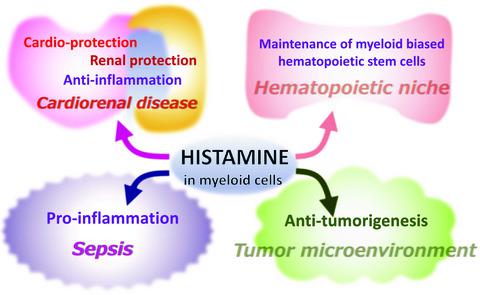当前位置:
X-MOL 学术
›
Genes Cells
›
论文详情
Our official English website, www.x-mol.net, welcomes your feedback! (Note: you will need to create a separate account there.)
Histamine and histidine decarboxylase: Immunomodulatory functions and regulatory mechanisms.
Genes to Cells ( IF 2.1 ) Pub Date : 2020-05-12 , DOI: 10.1111/gtc.12774 Takashi Moriguchi 1 , Jun Takai 1
Genes to Cells ( IF 2.1 ) Pub Date : 2020-05-12 , DOI: 10.1111/gtc.12774 Takashi Moriguchi 1 , Jun Takai 1
Affiliation

|
Histamine is a bioactive monoamine that is synthesized by the enzymatic activity of histidine decarboxylase (HDC) in basophils, mast cells, gastric enterochromaffin‐like (ECL) cells and histaminergic neuronal cells. Upon a series of cellular stimuli, these cells release stored histamine, which elicits allergies, inflammation, and gastric acid secretion and regulates neuronal activity. Recent studies have shown that certain other types of myeloid lineage cells also produce histamine with HDC induction under various pathogenic stimuli. Histamine has been shown to play a series of pathophysiological roles by modulating immune and inflammatory responses in a number of disease conditions, whereas the mechanistic aspects underlying induced HDC expression remain elusive. In the present review, we summarize the current understanding of the regulatory mechanism of Hdc gene expression and the roles played by histamine in physiological contexts as well as pathogenic processes. We also introduce a newly developed histaminergic cell‐monitoring transgenic mouse line (Hdc‐BAC‐GFP) that serves as a valuable experimental tool to identify the source of histamine and dissect upstream regulatory signals.
中文翻译:

组胺和组氨酸脱羧酶:免疫调节功能和调节机制。
组胺是一种具有生物活性的单胺,由组氨酸脱羧酶(HDC)在嗜碱性粒细胞,肥大细胞,胃肠嗜铬样蛋白(ECL)细胞和组胺能神经元细胞中的酶促活性合成。受到一系列细胞刺激后,这些细胞释放储存的组胺,引起过敏,炎症和胃酸分泌并调节神经元活性。最近的研究表明,某些其他类型的髓系细胞也可以在各种病原刺激下通过HDC诱导产生组胺。组胺已显示出通过调节多种疾病条件下的免疫和炎性反应而发挥一系列病理生理作用,而导致HDC表达的机制仍然难以捉摸。在目前的评论中,Hdc基因表达以及组胺在生理环境和致病过程中的作用。我们还介绍了一种新开发的组胺能细胞监测转基因小鼠品系(Hdc -BAC-GFP),可作为鉴定组胺来源和解剖上游调节信号的宝贵实验工具。
更新日期:2020-07-17
中文翻译:

组胺和组氨酸脱羧酶:免疫调节功能和调节机制。
组胺是一种具有生物活性的单胺,由组氨酸脱羧酶(HDC)在嗜碱性粒细胞,肥大细胞,胃肠嗜铬样蛋白(ECL)细胞和组胺能神经元细胞中的酶促活性合成。受到一系列细胞刺激后,这些细胞释放储存的组胺,引起过敏,炎症和胃酸分泌并调节神经元活性。最近的研究表明,某些其他类型的髓系细胞也可以在各种病原刺激下通过HDC诱导产生组胺。组胺已显示出通过调节多种疾病条件下的免疫和炎性反应而发挥一系列病理生理作用,而导致HDC表达的机制仍然难以捉摸。在目前的评论中,Hdc基因表达以及组胺在生理环境和致病过程中的作用。我们还介绍了一种新开发的组胺能细胞监测转基因小鼠品系(Hdc -BAC-GFP),可作为鉴定组胺来源和解剖上游调节信号的宝贵实验工具。



























 京公网安备 11010802027423号
京公网安备 11010802027423号